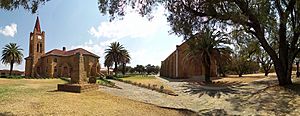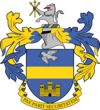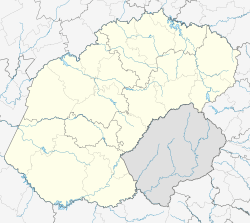Vredefort facts for kids
Quick facts for kids
Vredefort
|
||
|---|---|---|

Nederduitse Gereformeerde Church, Church Street, Vredefort
|
||
|
||
| Country | South Africa | |
| Province | Free State | |
| District | Fezile Dabi | |
| Municipality | Ngwathe | |
| Established | 1878 | |
| Area | ||
| • Total | 21.4 km2 (8.3 sq mi) | |
| Population
(2011)
|
||
| • Total | 14,619 | |
| • Density | 683.1/km2 (1,769/sq mi) | |
| Racial makeup (2011) | ||
| • Black African | 92.4% | |
| • Coloured | 2.1% | |
| • Indian/Asian | 0.3% | |
| • White | 5.0% | |
| • Other | 0.3% | |
| First languages (2011) | ||
| • Sotho | 68.9% | |
| • Xhosa | 15.7% | |
| • Afrikaans | 7.7% | |
| • Zulu | 1.6% | |
| • Other | 6.0% | |
| Time zone | UTC+2 (SAST) | |
| Postal code (street) |
9595
|
|
| PO box |
9595
|
|
| Area code | 056 | |
Vredefort is a small farming town in the Free State province of South Africa. About 3,000 people live here. Farmers in Vredefort grow crops like peanuts, sorghum, sunflowers, and maize. They also raise cattle.
This town is special because it sits inside the Vredefort impact structure. This is the largest and oldest visible crater on Earth. It was made by a huge space rock!
Contents
Vredefort: A Town with a Giant Secret
What is Vredefort?
Vredefort was started in 1876. It was built on a farm called Visgat. The town's name means "peace fort" in Afrikaans and Dutch. This name came from a time when a possible war between the Transvaal and the Orange Free State was avoided peacefully.
The Vredefort Dome: A Giant Crater
The Vredefort impact structure is often called the Vredefort Dome. It is the biggest and one of the oldest known places on Earth where an asteroid hit. The crater is about 300 kilometers (186 miles) wide.
How the Dome Formed
About 2.02 billion years ago, a huge space rock, called a bolide, crashed into Earth. This bolide was about 10 kilometers (6 miles) wide. The massive impact created the Vredefort Dome. This event also helped to protect the gold deposits found in the Free State.
Why the Dome is Special
The Vredefort Dome is very important for science. It helps us understand how planets form and how impacts affect them. Because of its unique features, it was named a World Heritage Site by UNESCO. This means it is a place of special cultural or physical importance to the world. It is South Africa's seventh World Heritage Site. Scientists from Wits University worked hard to get it this special status.
A Look at Vredefort's History
During the Second Boer War, the British army built a camp here. This camp was a place where Boer women and children stayed during the war.
Famous People from Vredefort
Some well-known people have connections to Vredefort:
- Alba Bouwer
- T.T. Cloete
- Hendrik van den Bergh




